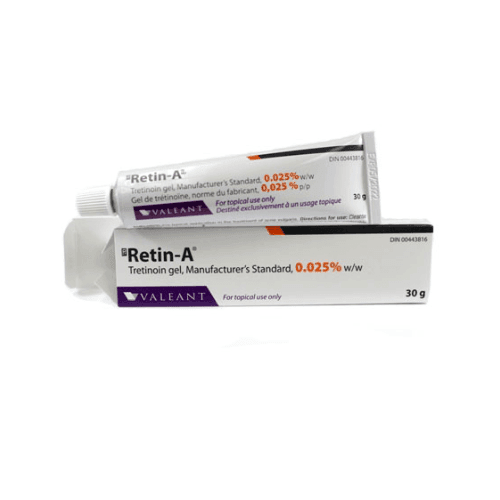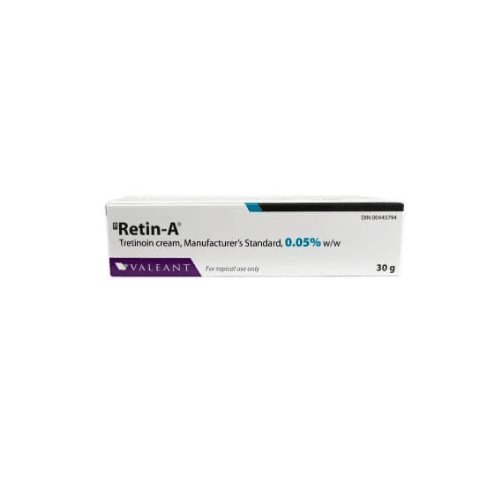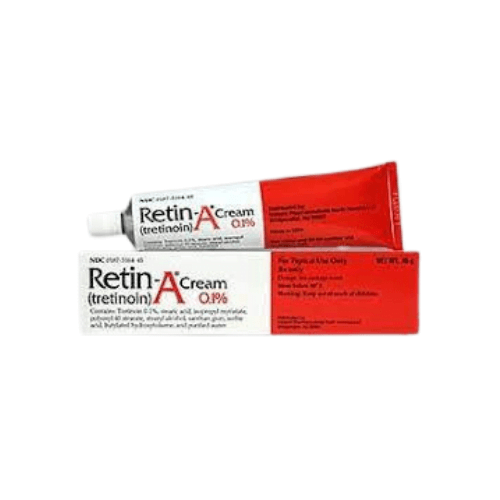Shipping with this method takes 3-5 days
Retin-A® Cream for Acne
$45.99
Secure Encrypted Payments
Retin-A® Cream is a prescription topical retinoid used to treat acne. It supports clearer skin by helping unclog pores and normalize cell turnover. This page explains how it works, safe use, and storage so you can order confidently with US shipping from Canada. It also outlines access options for Retin-A without insurance.
What Retin-A Is and How It Works
Retin-A® contains tretinoin, a vitamin A derivative and retinoid. It acts on the skin to reduce microcomedones, normalize shedding of dead cells, and keep pores clear. Over time, this helps limit new blemishes. The cream may cause mild irritation at first as your skin adjusts.
YouDrugstore is a licensed Canadian pharmacy in Manitoba. Pharmacists review prescriptions before dispensing.
Retin-A Cream is applied to acne-prone areas in a very thin layer. It should not be used as a spot treatment only; consistent, gentle use across affected areas is important. Avoid the eyes, nostrils, and mouth. Use a non-comedogenic moisturizer and broad-spectrum sunscreen while using this medicine.
Who It’s For
This treatment is indicated for acne vulgaris in people for whom a prescriber recommends topical tretinoin. It may be considered when whiteheads, blackheads, or inflammatory lesions are present. People with very sensitive skin may need cautious introduction under guidance.
Do not use if you have a known hypersensitivity to tretinoin or any component of the cream. Avoid applying to sunburned, eczematous, or abraded skin. If pregnant or planning pregnancy, discuss risks and benefits with your healthcare professional. Limit or avoid sunlamps and tanning beds due to heightened photosensitivity.
Dosage and Usage
Use exactly as directed by your prescriber and the product label. Typical use is once daily in the evening. Wash with a mild cleanser and gently pat dry. Waiting a short period after washing before applying can help reduce stinging. Apply a pea-sized amount for the entire face, spreading a thin film over affected areas rather than layering. More cream does not improve results and can increase irritation.
Keep other skincare simple. Non-comedogenic moisturizers and gentle cleansers are preferred. Avoid harsh scrubs, astringents, or products with high alcohol content. If combining with benzoyl peroxide or topical antibiotics, your prescriber may suggest different application times to limit irritation. Always follow the official Patient Information when uncertain.
Strengths and Forms
The cream is one of several topical tretinoin presentations. It is suitable for normal to dry skin types who may prefer a cream base over gels. Availability can vary by pharmacy and jurisdiction.
Common options include the branded cream and other tretinoin formulations. Where supplied, Retin-A Cream 0.05 may be available alongside alternative formulations. Your prescriber will choose a formulation that fits your skin type and treatment goals.
Missed Dose and Timing
If you forget an application, use it at the next scheduled time. Do not double up or apply extra. Overuse can increase redness, peeling, or discomfort without improving acne control. Consistency over weeks matters more than occasional missed doses.
Allow the cream to dry before applying other products. Makeup can be used after the cream has absorbed. If irritation occurs, speak with your prescriber about adjusting your routine.
Storage and Travel Basics
Store the tube at room temperature as directed on the label. Keep it tightly closed and away from excessive heat or open flame. Do not freeze. Keep out of reach of children and pets.
For travel, pack the tube in your carry-on to avoid extreme temperatures. Keep it in original packaging with your prescription label. You can store it in a small toiletry bag to prevent leaks. If flying, place it in a resealable bag with other liquids per security rules. Avoid leaving it in a hot car.
Benefits
This medicine supports clearer skin by targeting the formation of comedones. It helps reduce blocked pores and may improve skin texture over time. Using a retinoid can also support results from other acne therapies prescribed for you.
Once-daily use fits well with simple evening routines. The cream base can be more comfortable for dry or combination skin compared to some gels.
Side Effects and Safety
- Skin redness or warmth
- Dryness and flaking
- Peeling or mild burning
- Stinging or itch
- Sun sensitivity
Serious reactions are uncommon but can include severe irritation, swelling, blistering, or allergic contact dermatitis. Stop use and seek medical advice if you experience severe skin reactions or signs of allergy. Sunburn risk increases; daily sunscreen, protective clothing, and shade are recommended. If you also use photosensitizing medicines, review the plan with your prescriber.
Drug Interactions and Cautions
Use caution with concurrent topical acne products, especially those containing benzoyl peroxide, salicylic acid, sulfur, or resorcinol, as combined irritation can occur. Limit exfoliants and abrasive cleansers. Hair removal with waxing on treated skin can cause irritation; consider alternatives. Take care with medicines that increase sun sensitivity.
Topical retinoids are for external use only. Avoid contact with eyes, lips, and mucous membranes. If contact occurs, rinse with water. If you experience persistent irritation, consult your healthcare professional for guidance.
What to Expect Over Time
Skin may feel drier and appear slightly red early in treatment. This typically settles as your skin adapts. Gradual improvement in comedones and texture may be observed with ongoing use. Your prescriber may adjust your skincare routine to help with tolerability. Staying consistent and using gentle moisturizers can support comfort.
Results vary among individuals. Follow your clinician’s plan and keep using sunscreen. If your routine changes seasonally, discuss adjustments to maintain comfort and adherence.
Compare With Alternatives
Other topical options include azelaic acid and different retinoid bases. Oral therapies can be considered for more severe or resistant acne. Some patients may use a topical retinoid with benzoyl peroxide or antibiotics as part of a regimen designed by a prescriber.
We also carry Finacea and Clarus, which address acne under clinical guidance. A prescriber may also recommend Generic Tretinoin Cream if suitable for your skin type and treatment plan.
For broader reading, explore condition pages like Acne, Hyperpigmentation, and our Dermatology category. You can also learn more from related articles such as Clarus Acne Treatment and Finacea Azelaic Acid Uses.
Pricing and Access
Buying through a licensed pharmacy can offer value compared with some local cash-pay options. If your prescriber agrees, you can purchase tretinoin online after providing a valid prescription. We display current pricing and formulations when in stock. Orders Ships from Canada to US with clear fulfilment updates. Our checkout is encrypted for your security.
Insurance coverage varies. Some patients use an HSA or FSA card if eligible. You can compare the product page details and discuss options with your prescriber before ordering.
Availability and Substitutions
Stock changes over time. If a specific pack or strength is unavailable, your prescriber may recommend an appropriate alternative. This could include a different base or a generic formulation, depending on clinical needs and access.
For budgeting discussions, ask about the Tretinoin cash price versus other therapies. Your clinician may weigh costs alongside skin type and tolerance when suggesting substitutions.
Patient Suitability and Cost-Saving Tips
People with acne who can use topical retinoids under medical guidance may be candidates. Those with frequent sun exposure, very sensitive skin, or concurrent irritating treatments may need tailored routines. If you are breastfeeding, pregnant, or planning pregnancy, review risks and benefits with your healthcare professional before use.
Practical savings tips include considering multi-month refills when appropriate, setting reminders to reorder before you run out, and asking whether Tretinoin Cream 0.025 or a different strength is suitable for your skin. Keep your routine simple to improve adherence and reduce waste. Store your tube properly so you do not need to replace it early.
Questions to Ask Your Clinician
- Starting plan: how often to apply at first
- Moisturizer choice: which products pair well
- Sun care: sunscreen type and frequency
- Combination therapy: when to add benzoyl peroxide
- Irritation plan: what to do if peeling persists
- Pregnancy and nursing: suitability and precautions
Authoritative Sources
Ready to proceed? You can place your order with prompt, express shipping and temperature-controlled handling when required, with US delivery from Canada. This information is not a substitute for professional medical advice; always follow your prescriber’s directions and the official label.
Express Shipping - from $25.00
Prices:
- Dry-Packed Products $25.00
- Cold-Packed Products $35.00
Shipping Countries:
- United States (all contiguous states**)
- Worldwide (excludes some countries***)
Standard Shipping - $15.00
Shipping with this method takes 5-10 days
Prices:
- Dry-Packed Products $15.00
- Not available for Cold-Packed products
Shipping Countries:
- United States (all contiguous states**)
- Worldwide (excludes some countries***)
How long does it take topical tretinoin to show results?
Many people notice skin dryness and mild irritation early in therapy, with gradual improvements developing over time. Acne severity, skin type, and routine all influence response. Consistent nightly use as directed, gentle cleansing, daily sunscreen, and a suitable moisturizer can support comfort. Your prescriber may adjust your routine if irritation is persistent. Follow the official label and your clinician’s guidance for the safest plan for your skin.
Can I use benzoyl peroxide with a tretinoin cream?
Combination regimens are common, but layering can increase irritation. Your prescriber may recommend applying benzoyl peroxide in the morning and the retinoid at night, or on alternating days. Avoid harsh scrubs and astringents. If significant redness, burning, or peeling develops, contact your healthcare professional. Always follow your prescriber’s written instructions and the patient leaflet for both products.
What should I avoid while using this acne cream?
Avoid sunlamps and tanning beds, and use daily sunscreen and protective clothing. Limit abrasive cleansers, strong chemical exfoliants, and products with high alcohol content. Do not wax treated skin. Keep the cream off eyes, lips, and mucous membranes. If you take photosensitizing medicines, discuss additional precautions. If severe irritation occurs, pause and seek clinical advice before resuming.
Is topical tretinoin safe during pregnancy or breastfeeding?
Safety in pregnancy has not been established. Discuss risks and benefits with your healthcare professional before use if you are pregnant, planning pregnancy, or breastfeeding. If a retinoid is not appropriate, your prescriber may recommend other acne therapies better suited to that period. Always use medicines under medical supervision and follow the product label.
How much should I apply to my face?
A pea-sized amount is a common guide for the entire face unless your prescriber advises otherwise. Spread a thin film over affected areas rather than layering. Using more than recommended can increase irritation and will not improve results. Allow the skin to dry after washing before application to help reduce stinging. Follow the directions on your prescription label.
Can makeup or moisturizer be used with tretinoin?
Yes, non-comedogenic moisturizers are often recommended to improve comfort. Apply the retinoid first, let it absorb, then use moisturizer. Makeup can be applied after the cream dries. Choose gentle, fragrance-free products when possible. Daily sunscreen is important due to increased photosensitivity. If irritation persists, consult your healthcare professional for adjustments to your routine.
What if my skin becomes very irritated?
Temporary redness, peeling, and dryness can occur, especially early on. Using a gentle cleanser and non-comedogenic moisturizer may help. If irritation becomes severe or painful, stop the product and speak with your prescriber. They may adjust your routine, suggest spacing applications, or consider another therapy. Do not use abrasive scrubs or harsh astringents while your skin is irritated.



